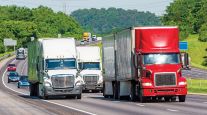Letter: A Future Vision for Diesel Engines
I read with a skeptical eye the article quoting Mr. Roger Nielsen on the demise of the diesel (Transport Topics 4-29, p. 1). It’s true that the clipper ship Cutty Sark had only a decade before the age of steam kicked her off her pedestal as the fastest way to transport tea, but I also wonder if Mr. Nielsen’s predicted demise of the diesel engine may turn out to be an exaggeration.
READ THE ARTICLE: End of Diesel Engines Is In Sight, Daimler’s Roger Nielsen Says
Of course, I am prejudiced as technical director of a small diesel combustion research venture. But, I do wonder if a flying leap into the future is as sure a path as one that also considers how far the diesel has come, and how far it may yet go before joining the sailing ship as a museum piece. I wonder if Mr. Nielsen and his associates have fully considered the advanced engineering work being done both on diesel architecture and combustion.
I, for one, can envision a diesel truck of the future incorporating the following enhancements:
A diesel engine employing Achates opposed-piston, two-stroke architecture, which retains heat much better than present engines while easing breathing. Such an engine, nearly 20% more efficient than present engines, might well be enhanced by an HCCI or SCCI (homogeneous- or stratified-charge-compression ignition) pre-mixed diesel combustion system, long advocated by the Department of Energy. Such advanced combustion would raise diesel efficiency even further, to levels undreamed of, while also offering benefits in terms of specific output, lower noise level and heat rejection, weight savings, extended oil changes and likely the elimination of the need for a diesel particulate filter.
Combine such an engine with a high-efficiency, hybrid drivetrain that would recover nearly all braking energy while also handling hotel loads via the hybrid generator/battery system. Add an extremely advanced, unified aero cab and trailer design of the type only existent in various prototypes these days, and then provide a biodiesel/petroleum fuel blend composed of as much as a 60% green fuel.
WRITE A LETTER TO THE EDITOR: Fill out this form
Compare such a vehicle with an electric truck powered via a grid largely fed by solar and wind power, but still employing at least 15% fossil generation on average to make up for the variations in climate as they affect green sources and the limitations of battery storage. The reduction in carbon footprint might be surprisingly compatible.
Add to this the inherent conservatism of the trucking industry — especially in sectors like owner-operator small fleets, where the tradition of running a diesel runs extremely deep — and the possible continued need for diesels in remote areas, and one can envision a future that could well prove to be a blend of electric trucks and extremely advanced diesel-powered designs.
John Baxter
Technical Director
Advance Diesel Concepts




